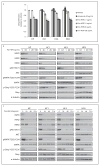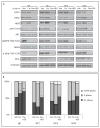Targeting the HER Family with Pan-HER Effectively Overcomes Resistance to Cetuximab
- PMID: 27422810
- PMCID: PMC5010956
- DOI: 10.1158/1535-7163.MCT-16-0012
Targeting the HER Family with Pan-HER Effectively Overcomes Resistance to Cetuximab
Abstract
Cetuximab, an antibody against the EGFR, has shown efficacy in treating head and neck squamous cell carcinoma (HNSCC), metastatic colorectal cancer, and non-small cell lung cancer (NSCLC). Despite the clinical success of cetuximab, many patients do not respond to cetuximab. Furthermore, virtually all patients who do initially respond become refractory, highlighting both intrinsic and acquired resistance to cetuximab as significant clinical problems. To understand mechanistically how cancerous cells acquire resistance, we previously developed models of acquired resistance using the H226 NSCLC and UM-SCC1 HNSCC cell lines. Cetuximab-resistant clones showed a robust upregulation and dependency on the HER family receptors EGFR, HER2, and HER3. Here, we examined pan-HER, a mixture of six antibodies targeting these receptors on cetuximab-resistant clones. In cells exhibiting acquired or intrinsic resistance to cetuximab, pan-HER treatment decreased all three receptors' protein levels and downstream activation of AKT and MAPK. This correlated with decreased cell proliferation in cetuximab-resistant clones. To determine whether pan-HER had a therapeutic benefit in vivo, we established de novo cetuximab-resistant mouse xenografts and treated resistant tumors with pan-HER. This regimen resulted in a superior growth delay of cetuximab-resistant xenografts compared with mice continued on cetuximab. Furthermore, intrinsically cetuximab-resistant HNSCC patient-derived xenograft tumors treated with pan-HER exhibited significant growth delay compared with vehicle/cetuximab controls. These results suggest that targeting multiple HER family receptors simultaneously with pan-HER is a promising treatment strategy for tumors displaying intrinsic or acquired resistance to cetuximab. Mol Cancer Ther; 15(9); 2175-86. ©2016 AACR.
©2016 American Association for Cancer Research.
Conflict of interest statement
of Potential Conflicts of Interest: D.L. Wheeler holds a laboratory research agreement with Symphogen A/S. J. Lantto, I.D. Horak, and M. Kragh are employed by Symphogen A/S. No potential conflicts of interest were disclosed by other authors.
Figures







Similar articles
-
Overcoming acquired resistance to cetuximab by dual targeting HER family receptors with antibody-based therapy.Mol Cancer. 2014 Oct 24;13:242. doi: 10.1186/1476-4598-13-242. Mol Cancer. 2014. PMID: 25344208 Free PMC article.
-
Simultaneous targeting of EGFR, HER2, and HER4 by afatinib overcomes intrinsic and acquired cetuximab resistance in head and neck squamous cell carcinoma cell lines.Mol Oncol. 2018 Jun;12(6):830-854. doi: 10.1002/1878-0261.12197. Epub 2018 May 1. Mol Oncol. 2018. PMID: 29603584 Free PMC article.
-
Erlotinib is a viable treatment for tumors with acquired resistance to cetuximab.Cancer Biol Ther. 2011 Sep 1;12(5):436-46. doi: 10.4161/cbt.12.5.16394. Epub 2011 Sep 1. Cancer Biol Ther. 2011. PMID: 21725209 Free PMC article.
-
Cetuximab: an epidermal growth factor receptor chemeric human-murine monoclonal antibody.Drugs Today (Barc). 2005 Feb;41(2):107-27. doi: 10.1358/dot.2005.41.2.882662. Drugs Today (Barc). 2005. PMID: 15821783 Review.
-
Epidermal Growth Factor Receptor Inhibition in Squamous Cell Carcinoma of the Head and Neck.Hematol Oncol Clin North Am. 2015 Dec;29(6):1011-32. doi: 10.1016/j.hoc.2015.07.007. Hematol Oncol Clin North Am. 2015. PMID: 26568545 Review.
Cited by
-
Randomized phase II study of preoperative afatinib in untreated head and neck cancers: predictive and pharmacodynamic biomarkers of activity.Sci Rep. 2023 Dec 18;13(1):22524. doi: 10.1038/s41598-023-49887-4. Sci Rep. 2023. PMID: 38110561 Free PMC article. Clinical Trial.
-
Pyrotinib combined with CDK4/6 inhibitor in HER2-positive metastatic gastric cancer: A promising strategy from AVATAR mouse to patients.Clin Transl Med. 2020 Aug;10(4):e148. doi: 10.1002/ctm2.148. Clin Transl Med. 2020. PMID: 32898333 Free PMC article.
-
Pancreatic Cancer: Pathogenesis and Clinical Studies.MedComm (2020). 2025 Apr 2;6(4):e70162. doi: 10.1002/mco2.70162. eCollection 2025 Apr. MedComm (2020). 2025. PMID: 40182139 Free PMC article. Review.
-
3D cell culture alters signal transduction and drug response in head and neck squamous cell carcinoma.Oncol Lett. 2022 Jun;23(6):177. doi: 10.3892/ol.2022.13297. Epub 2022 Apr 14. Oncol Lett. 2022. PMID: 35464304 Free PMC article.
-
Simultaneous targeting of HER family pro-survival signaling with Pan-HER antibody mixture is highly effective in TNBC: a preclinical trial with PDXs.Breast Cancer Res. 2020 May 15;22(1):48. doi: 10.1186/s13058-020-01280-z. Breast Cancer Res. 2020. PMID: 32414394 Free PMC article.
References
-
- Yarden Y, Pines G. The ERBB network: at last, cancer therapy meets systems biology. Nat Rev Cancer. 2012;12:553–63. - PubMed
-
- Citri A, Yarden Y. EGF-ERBB signalling: towards the systems level. Nat Rev Mol Cell Biol. 2006;7:505–16. - PubMed
-
- Ang KK, Andratschke NH, Milas L. Epidermal growth factor receptor and response of head-and-neck carcinoma to therapy. Int J Radiat Oncol Biol Phys. 2004;58:959–65. - PubMed
-
- Nicholson RI, Gee JM, Harper ME. EGFR and cancer prognosis. European journal of cancer. 2001;37(Suppl 4):S9–15. - PubMed
MeSH terms
Substances
Grants and funding
LinkOut - more resources
Full Text Sources
Other Literature Sources
Research Materials
Miscellaneous

